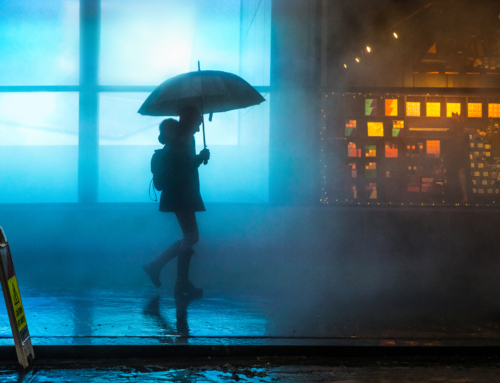I am a knitter. According to some translations of Psalm 139 God is also a knitter. There is some dispute whether “knit” is an accurate translation from the Hebrew but it is an appropriate verb to describe God’s intentional, methodical, individual methods of creating a person.
Knitting builds one object at a time.
The Psalmist says “you knit me together in my mother’s womb” which depicts a sculptural process of knitting an intricate and individual item. Knitting is flexible, sculptural, but not terribly efficient. It’s a loving form of art where the artist spends time with the project, enjoying the process of creating. It can take me up to 20 hours to knit one sock, which seems silly when I can buy a multi-pack at the store in five minutes. I do it because I treasure the time spent with the project I’m working on. If what I’m making is a gift, it has even more of a relational aspect to it.

These slippers are knitted using 4 needles to sculpt them into a foot-shape. I knitted these during the isolation of 2020 for all the children in my life.
Knitting is built stitch by stitch.
It’s an endless series of loops of string, building on each other, spiraling up and up and up until the project is complete – reminiscent of DNA. The materials chosen are crucial to the project fulfilling its purpose. I may choose super bulky wool which is quick and water resistant (great for a kids’ poncho – knit quickly before they grow out of it, and providing some protection from rain). Or I may choose extremely fine silk/mohair (perfect for a wedding shawl – deceptively warm while not obscuring the view of the dress beneath). If we trust God we will trust His use of materials. We can know that whichever body He has given us, whatever our abilities or disabilities may be, we are fearfully and wonderfully made. Ponchos and wedding shawls, like people with and without disabilities, are both needed and good.
Knitting is methodical and intentional.
The knitter chooses each specific stitch. If I want my item to get smaller as I knit (for example, a sleeve is wide at the bicep but narrow at the wrist) I need to decrease my stitches. In simple terms I need to knit two stitches together every so often. But how I do that is important to the finished piece and I have a myriad of possible methods to use. If you don’t knit, you may not think it matters much which method I use. But I understand, and it does matter. We may not understand why God might allow a child to have a third part to their twenty-first chromosome, resulting in Down Syndrome, but He understands. He knows the plans He has for that child. As each stitch has a purpose, so does each chromosome, each gene, each cell. Each person.

Knitting is often a mystery
Knitting in progress is often indecipherable (to all but the knitter) as the stitches bunch up on the needles and pieces may still be missing. Sometimes it looks like a mistake. The knitter has a view in mind though of what the finished piece will be: they know the purpose they have for it. They may have seen the pattern they are following, may have sketched it out, or are simply holding an image in their mind. The finished creation is not hidden from the knitter. God is not surprised when a person is born. He knew them from the very beginning and worked steadily to make them into a reality.

A baby blanket looks like a tangled mess until you bind off the last stitch and lay it out flat.
Knitting is never useless
Even when tragedy strikes, knitting can always be redeemed. If a dog tears apart a brand new hank of yarn, the small pieces can be salvaged, spliced together, and made into a cushion. (See photographic evidence below). If a sweater shrinks in the wash, it can be cut and sewn into a purse. A sweater that falls out of fashion can be unravelled and remade into a new style. Psalm 139:16 says “all the days ordained for me were written in your book before one of them came to be.” I believe each person can claim that to be true. Whether a disability is congenital or acquired there are days ordained for that person to live out as only their Creator knows how.

Knitting doesn’t always look useful
Even when a piece is finished, out of context it may not make sense to observers. Strange oblong bits with buttons on the ends seem useless. Gloves with only the very fingertips missing seem like a mistake. A shawl that is much too large and heavy to wear comfortably seems impractical. Mittens that are short and oddly-shaped seem like they won’t fit anyone.

But in the context they were meant for, each serves a unique purpose and enhances the lives of the people around them. The buttoned pieces are mask extenders to protect the ears of support workers during a pandemic. The gloves without fingertips allow the courier driver to keep his arthritic knuckles warm while using his touchscreen computer. The large and heavy shawl stacks up to be a neck brace on days when I struggle to hold my head up. The short mittens are custom fit for hands that were formed under the influence of thalidomide.
Conclusion: Giftedness
Judith Snow speaks of giftedness and specifically how that relates to people with disabilities: “all gifts add to the mosaic of the potential available community.”[1] Some gifts are not readily apparent but Judith says that all people have at least two gifts that they bring to any situation: presence and difference. Each person enters a context as their own unique self, offering one half of a meaningful interaction.
As we encounter each other in our communities may we recognize the unique gifts God has knitted into each of us. May we partner together to bring about meaningful interactions and, ultimately, create communities where every body belongs.

This knitted shawl works better (and looks better) than the neck brace I purchased at the pharmacy.
[1] Jack Pearpoint and Judith Snow, From Behind the Piano: The Building of Judith Snow’s Unique Circle of Friends and What’s Really Worth Doing and How to Do It: A Book for People Who Love Someone Labeled Disabled (Possibly Yourself) (Toronto: Inclusion Press, 1998), 3






I love crochet for the same reason. Find knitting too hard on my wrists.